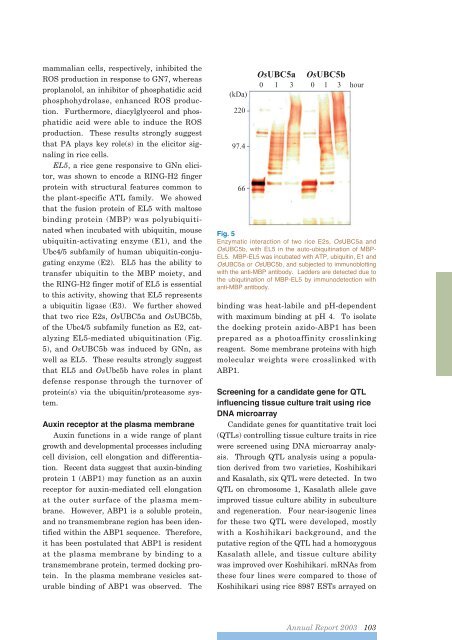You also want an ePaper? Increase the reach of your titles
YUMPU automatically turns print PDFs into web optimized ePapers that Google loves.
mammalian cells, respectively, inhibited theROS production in response to GN7, whereasproplanolol, an inhibitor of phosphatidic acidphosphohydrolase, enhanced ROS production.Furthermore, diacylglycerol and phosphatidicacid were able to induce the ROSproduction. These results strongly suggestthat PA plays key role(s) in the elicitor signalingin rice cells.EL5, a rice gene responsive to GNn elicitor,was shown to encode a RING-H2 fingerprotein with structural features common tothe plant-specific ATL family. We showedthat the fusion protein of EL5 with maltosebinding protein (MBP) was polyubiquitinatedwhen incubated with ubiquitin, mouseubiquitin-activating enzyme (E1), and theUbc4/5 subfamily of human ubiquitin-conjugatingenzyme (E2). EL5 has the ability totransfer ubiquitin to the MBP moiety, andthe RING-H2 finger motif of EL5 is essentialto this activity, showing that EL5 representsa ubiquitin ligase (E3). We further showedthat two rice E2s, OsUBC5a and OsUBC5b,of the Ubc4/5 subfamily function as E2, catalyzingEL5-mediated ubiquitination (Fig.5), and OsUBC5b was induced by GNn, aswell as EL5. These results strongly suggestthat EL5 and OsUbc5b have roles in plantdefense response through the turnover ofprotein(s) via the ubiquitin/proteasome system.Auxin receptor at the plasma membraneAuxin functions in a wide range of plantgrowth and developmental processes includingcell division, cell elongation and differentiation.Recent data suggest that auxin-bindingprotein 1 (ABP1) may function as an auxinreceptor for auxin-mediated cell elongationat the outer surface of the plasma membrane.However, ABP1 is a soluble protein,and no transmembrane region has been identifiedwithin the ABP1 sequence. Therefore,it has been postulated that ABP1 is residentat the plasma membrane by binding to atransmembrane protein, termed docking protein.In the plasma membrane vesicles saturablebinding of ABP1 was observed. The(kDa)22097.466OsUBC5a OsUBC5b0 1 3 0 1 3 hourFig. 5Enzymatic interaction of two rice E2s, OsUBC5a andOsUBC5b, with EL5 in the auto-ubiquitination of MBP-EL5. MBP-EL5 was incubated with ATP, ubiquitin, E1 andOsUBC5a or OsUBC5b, and subjected to immunoblottingwith the anti-MBP antibody. Ladders are detected due tothe ubiqutination of MBP-EL5 by immunodetection withanti-MBP antibody.binding was heat-labile and pH-dependentwith maximum binding at pH 4. To isolatethe docking protein azido-ABP1 has beenprepared as a photoaffinity crosslinkingreagent. Some membrane proteins with highmolecular weights were crosslinked withABP1.Screening for a candidate gene for QTLinfluencing tissue culture trait using riceDNA microarrayCandidate genes for quantitative trait loci(QTLs) controlling tissue culture traits in ricewere screened using DNA microarray analysis.Through QTL analysis using a populationderived from two varieties, Koshihikariand Kasalath, six QTL were detected. In twoQTL on chromosome 1, Kasalath allele gaveimproved tissue culture ability in subcultureand regeneration. Four near-isogenic linesfor these two QTL were developed, mostlywith a Koshihikari background, and theputative region of the QTL had a homozygousKasalath allele, and tissue culture abilitywas improved over Koshihikari. mRNAs fromthese four lines were compared to those ofKoshihikari using rice 8987 ESTs arrayed on<strong>Annual</strong> <strong>Report</strong> <strong>2003</strong> 103













